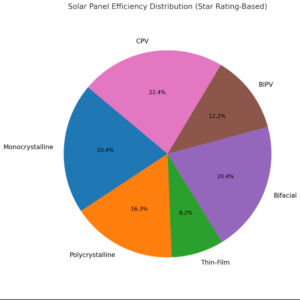Types of Solar Panels and Their Uses
As the world transitions toward sustainable energy solutions, solar panels have become a popular and reliable option for both residential and commercial users. But not all solar panels are created equal. With multiple types of solar panels available in the market today—each with its own unique features, efficiency ratings, and applications—it’s essential to understand their differences before investing in one.
In this blog, we’ll break down the major types of solar panels, compare their advantages, and help you choose the best solar panels for home use or business applications. Whether you’re curious about monocrystalline vs polycrystalline solar panels, thin-film solar technology, or modern BIPV solar solutions, this guide is designed to give you reliable, well-rounded information based on real-world performance and expert understanding.
1. Monocrystalline Solar Panels (Mono-Si)
High-efficiency residential & commercial applications Monocrystalline solar panels are made from a single, pure crystal structure. They are easily recognized by their uniform dark appearance and rounded edges.
Key Features:
– High solar panel efficiency ratings (15–22%)
– Space-efficient design—requires less roof area
– Longer lifespan (25+ years)
– Performs better in low-light conditions
Why Choose Them:
If you have limited roof space but want to maximize output, monocrystalline solar panels are often the best solar panels for home use.
2. Polycrystalline Solar Panels (Poly-Si)
Budget-conscious homeowners Polycrystalline panels are made from fragments of silicon crystals melted together. They usually have a bluish hue and a square-cut design.
Key Features:
– Moderate solar panel efficiency ratings (13–17%)
– More affordable than monocrystalline
– Slightly lower heat tolerance
When to Use:
They’re ideal for homeowners with ample roof space who want a more affordable entry point into solar without sacrificing too much performance.
3. Thin-Film Solar Technology
Portable setups, large-scale commercial installations, Thin-film solar panels are made by placing one or more layers of photovoltaic materials (like cadmium telluride or amorphous silicon) on a substrate.
Key Features:
– Lightweight and flexible
– Aesthetically seamless (used in building-integrated applications)
– Lower efficiency (10–12%) but cheaper to produce
Ideal Uses:
Perfect for curved surfaces, RVs, or BIPV solar solutions (Building-Integrated Photovoltaics).
4. Bifacial Solar Panels
Open space installations with reflective surfaces. Bifacial solar panels capture sunlight from both sides, increasing their total energy output.
Key Features:
– Up to 30% more efficient in ideal conditions
– Transparent or reflective backing enables dual-side generation
– Durable and long-lasting
Efficiency Boost:
If installed over reflective surfaces, bifacial solar panel efficiency can outpace traditional panels.
5. BIPV (Building-Integrated Photovoltaic) Solar Panels
Modern architectural solar designs. BIPV solar panels are integrated directly into building materials such as glass windows, facades, or rooftops.
Key Features:
– Dual functionality: structure + energy generation
– Visually aesthetic and seamless integration
– Lower wattage compared to traditional systems
Smart Use:
An excellent choice for new constructions or eco-smart buildings.
6. Concentrated Photovoltaic Systems (CPV)
High-efficiency commercial or research use in sunny regions, CPV systems use lenses or mirrors to focus sunlight onto high-efficiency solar cells.
Key Features:
– Exceptionally high efficiency (up to 40%+)
– Requires sun-tracking systems
– Not suited for residential use due to complexity and cost
Future Potential:
Concentrated photovoltaic systems show great promise for large-scale power plants.
The National Renewable Energy Laboratory (NREL) provides ongoing research and performance data on thin-film and other emerging solar technologies.
Choosing the Best Solar Panels for Home Use
When selecting the right residential solar panel options, it’s important to weigh your budget, space, local weather conditions, and aesthetic preferences. For most homeowners, monocrystalline or polycrystalline solar panels offer the best balance of performance and cost.

Emerging Trends in Solar Panel Innovation
As the solar industry continues to evolve, new innovations are pushing the boundaries of what solar panels can achieve. Perovskite solar cells, for example, are a promising technology currently under research due to their potential for higher efficiency and lower production costs compared to traditional silicon-based cells. Additionally, solar skins—aesthetic overlays that allow panels to blend seamlessly with rooftops—are gaining popularity in residential markets where appearance is a concern. These innovations, combined with advancements in smart inverters and solar tracking systems, are paving the way for more efficient, integrated, and visually appealing solar solutions for both homes and businesses.
Making a Smart Solar Choice
With so many solar panel types available, the best panel for you will depend on your specific goals—whether that’s high solar panel efficiency ratings, aesthetic appeal, or maximizing your return on investment.
Rather than focusing solely on price or trend, choose solar panels that align with your energy needs, long-term plans, and the physical characteristics of your home or site.


 Previous Post
Previous Post Next Post
Next Post